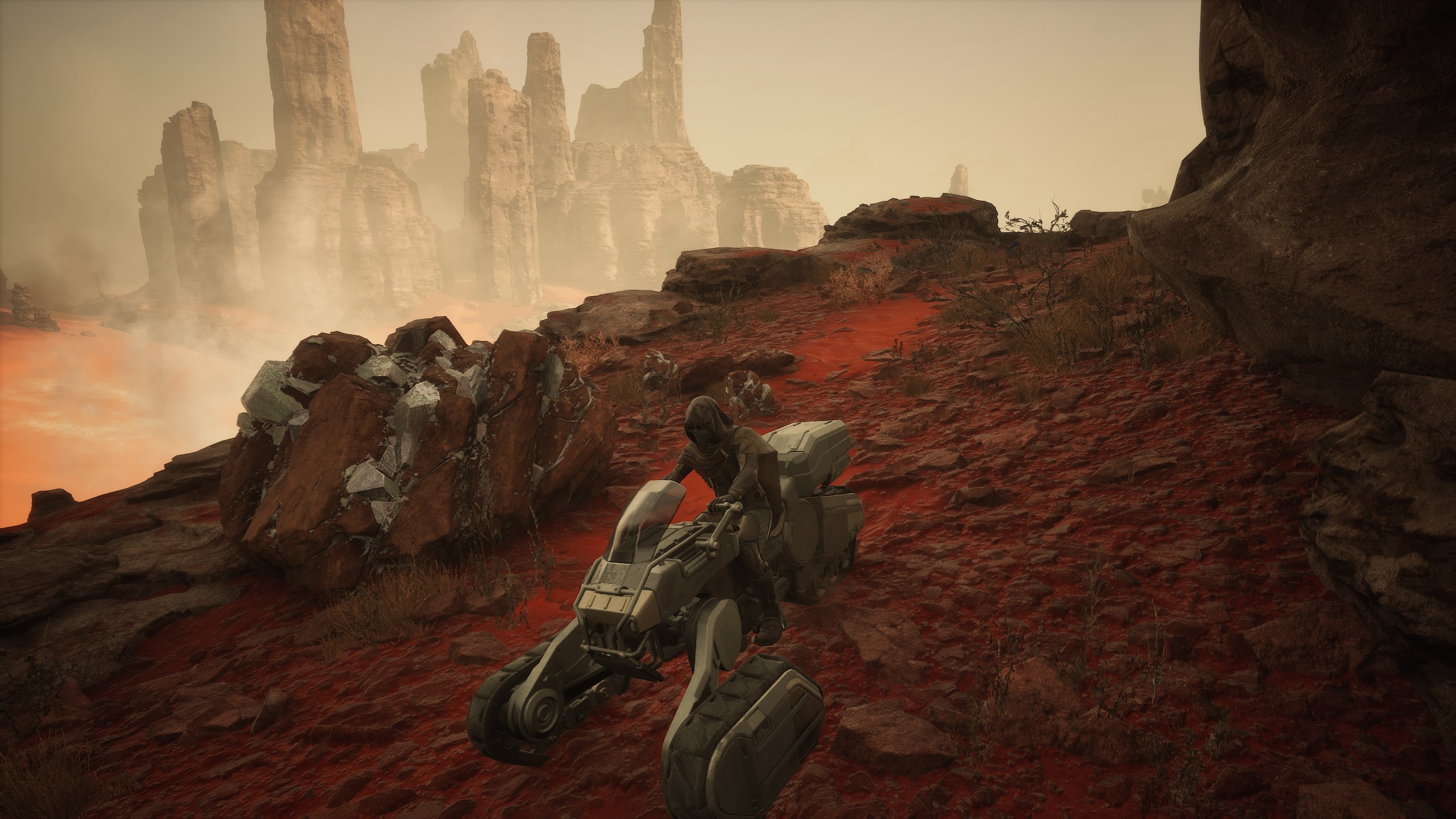
Dragon’s Dogma 2 Review
In a way, Dragon’s Dogma 2 reminds me of Sam Raimi’s Evil Dead 2, which was more of a remake of his first cult-classic comedy-horror movie than a sequel. The much bigger budget allowed Raimi to really dial in his true vision for Ash’s bad night with the bad book. Like Evil Dead 2, Dragon’s Dogma 2 doesn’t stray too far from the blueprint that turned it into a cult-classic action-RPG in its own right over the past decade, keeping its second-to-none action design and vague but robust and alluring world as its centerpieces. Like the 2012 original, it is unforgiving out of the gate thanks to brutal enemies and chaotic encounters that are not designed to gradually ease you in. It is also high levels of janky; all of its systems seem precariously fitted together, with the fragility of a well-pruned Jenga tower. Weird things happen all the time, and yet remarkably, it never fully falls over, and its open-ended design facilitates a potential for barely controlled chaos that makes some of these inconveniences feel almost intentional, even if they clearly aren’t.
The vast dark fantasy world we find ourselves in is different from the previous game’s but is similarly dense with unbeaten paths to wander down and secrets to find. Many will never make themselves known to you if you don’t go out of your way looking for them – talking with others after my first 33-hour playthrough of Dragon’s Dogma 2, it’s jarring how many things I just didn’t see. Traveling through the verdant forests and dusty crags is as dangerous as it is interesting. Early on, simply walking from quest point to quest point is a huge risk, as the wilds of Dragon’s Dogma 2 are filled with creatures who would love to make you lunch. Packs of smaller enemies work together to isolate you from assistance, wolves can literally drag you away from your group so that the pack can munch on you in peace. While many open-world games with day-and-night cycles stress the dangers of venturing out when the moon is high, I don’t know of any game that has a more brutal night than this one.
What we said about Dragon’s Dogma
It’s a strange game, Dragon’s Dogma; it does some really brave and interesting things, but it also feels unfinished, with technical problems that often spoil things. The combat, though, is one of the best real-time RPG fighting systems around, with flexibility and variety that carries the whole game. It deserves to be complemented by an absorbing fantasy world and an array of well-written quests and characters, but instead the quests get repetitive and the fiction is soporific. Dragon’s Dogma has the scale and challenge of a great action RPG, but not the character or polish. Nonetheless, if you can persist, there’s a lot to love here, and some great ideas that make you want to give it a chance. – Keza MacDonald, May 21, 2012
Score: 7.5
Read our full Dragon’s Dogma review.
On the whole, it’s hard to determine if this is easier or more difficult than the original Dragon’s Dogma. It lacks the cheesy difficulty spikes that fans of the first will remember, like some enemy groups hiding an unreasonably strong member among them, but it makes up for it in how quickly open battles can get out of hand. In the first few hours, having a squabble with wolves evolve into a rolling melee with every other beast within a square mile became annoyingly commonplace. Skirmishing goblins trying to keep their distance from you and harass at range might attract the attention of an ogre who now must mosh through the combat, and this in turn attracts the eye of a griffon to divebomb the encounter like a feathery wrecking ball. As both your strength and your knowledge of the map grows, you start to learn how to engage with enemy groups to make the potential for shenanigans more manageable. It’s a tough learning curve, but it eventually gives way to a rewarding feeling of walking through a valley that gave you heartache 10 hours ago and navigating it like a well-oiled machine.
The world has a strong sense of mystery that demands to be solved.
You’ll be doing lots of backtracking and exploring on foot, as there’s very little in the way of convenient fast traveling. Ferrystones, which whisk you away to specific markers in the different nations on the map, are out of any early game budget. Oxcarts, which move between cities more locally, only leave once a day, so you’ll need to catch them bright and early or wait for them to appear. These are not guaranteed safe options either, as you’ll regularly be called to defend carts against danger they come across mid-journey. On more than one occasion a fight with monsters has broken the cart to splinters, leaving me and my party to hike the rest of the way. It is a unique and sort of refreshing sense of precarity, but can still be incredibly frustrating all the same if it strands you in the middle of nowhere.
Even so, there is such a strong sense of mystery that demands to be solved that I found myself dusting myself off to get back on the road every time some terrible nonsense befell me. The explicit lack of waypoints and map markers for side stories really helps nail the feeling that you aren’t simply a walking taskbot for all of this world’s NPCs to wind up, but a curious member of a living, breathing place that will march on valiantly whether you find what you’re looking for or not.
I always wanted to explore everything though, if for no other reason than because most of the environments are stunning. Big cliffside ocean views steal the show, but even the deep caves and shadowy crypts have an eerie charm thanks to both clever lighting and scenery that follows that “lived-in” ethos through every nook and cranny.
This dynamism is present in Dragon’s Dogma 2’s story and quests as well. I wouldn’t call the main story at large all that remarkable: you play as a near-immortal chosen one – The Arisen – who has their heart stolen by a dragon that you will be forced to slay one day to save the world. It’s the exact same premise as the original Dragon’s Dogma, with a bit of a Game of Thrones-esque spin of political intrigue that is good, if not all that special in a world where every fantasy story has similar influences. But on a couple of occasions it takes a major turn and upends what you’ve come to know and expect so far. Additionally, I came to like particular characters more than the larger plot, like a strange hermit by the shore that felt like an Ernest Hemingway reference or the son of a powerful regent working to change his government from within.
Just like exploring the wild can yield treasure, cities reward curiosity.
The first time you walk into a city, you’ll be bombarded with people who are happy to see such a capable-looking problem solver in their midsts – even if you use the extremely flexible character creator to make yourself look like anything but. Many of the quests they offer you are pretty mundane RPG fare – fetch this item, kill those enemies, etc. – but some at least put a twist on these genre staples by adding time limits or unclear consequences. Yes, you just got three quests at once, but if one involves saving a kid from a pack of wolves, the clock is ticking down until he becomes dinner, so you’d best prioritize accordingly. Several quests I got in towns and cities involved me simply watching people behave strangely and following them around, eventually finding that my suspicion was justified. Just like exploring out in the wild can yield treasure, cities reward adventure and curiosity.
There’s no direct multiplayer of any kind in Dragon’s Dogma 2, but every Arisen is accompanied by a pawn – a sort of personal NPC sidekick whose purpose is to assist you on your journey. Pawns are invaluable because they can take on a class – I usually had mine act as a dedicated healer – and be another body in battle. But they’re plenty useful outside of a fight, too. They can gather resources and point out things of note in your surroundings, talk through hints about your next quest objectives, or share leads about new quests they may have gathered on their own. They did all of these things in the original game as well, but new specializations that can highlight harvesting spots on your map, organize the party’s inventories, or even craft on their own mean they add a lot more value this time around.
And while you’ll never run across another player, your pawn can, and that opens up all sorts of interesting possibilities that are all but unique to Dragon’s Dogma. Pawns can be sent through The Rift, the extra-dimensional plane from which they come, in order to join other players on their adventures, learn from their experiences and bring back items and knowledge to share with you – and you can continue to use them in your own world while they do that. When I’ve filled my group with pawns from other players (up two more to make a party of four) I just as often had pawns showing me stuff they’d found with their masters as I discovered new things myself, and these pawns would then learn and bring those secrets back to their home games. This clever asynchronous multiplayer system was groundbreaking in 2012, and feels just as innovative in 2024 because there’s still not much out there like it.
Pawns aren’t always a boon, though. I’d never want to leave the shelter of town without one, but thanks to inconsistent AI, they can get themselves in all sorts of trouble. They often get isolated by enemies and picked off, which means you need to run to their unconscious bodies to revive them or they will poof out of your world. I’ve had a lot of pawns die in pretty silly ways, mostly by falling off of narrow bridges because they made the terrible choice to fight in the middle of them. You can command them to help you, wait in place, etc, but these orders are finicky and don’t feel very responsive in the thick of things. Sometimes you literally can’t continue fighting without one of them to help you to your feet or to free you from the clutches of some terrible creature, but they take their sweet, agonizing time to do so.
The way a greatsword sends little runts flying is hard not to grin at.
Usually pawns are at least competent, though, and they ensure that combat is king in Dragon’s Dogma 2. When it clicks, it is peerless among its action-RPG contemporaries. The swinging, shooting, and chopping feels solid and satisfying every time you make contact. Similar to the original game, physics play a big part, and the way a mighty swing from a greatsword sends little runts flying is hard not to grin at. But there’s even more minutiae to this than is obvious at first. Bigger characters with longer limbs are better at grabbing and climbing onto enemies and resisting being knocked down, while smaller characters are generally faster and recover stamina more quickly. You can pick up objects – and even smaller enemies – and use them as projectiles. The more of your party that piles on to larger enemies, the harder it is for them to stand. There are so many of these nuances to learn and they make so many of your little decisions during a fight important, but if you don’t plumb through the manual before setting out, you’ll miss them. I admire the way Dragon’s Dogma 2 has given us the responsibility to set out and discover new things without hand holding, but at the same time small stuff like this would be difficult to discover on your own without guidance.
How you fight naturally depends on your class – which Dragon’s Dogma calls vocations – and if you’re a fan of this series you’ll be relieved to find that other than separating the melee and ranged portions of the old Strider into two separate choices this go around (Thief and Archer now), the returning vocations are just as excellent and diverse as they were in the previous game. Basic archetypes like Fighter and Mage hold down your front line and support playstyles, with advanced vocations further specializing into more offensive options like Warriors, who give up the Fighter’s shield and put both hands on the biggest weapons they can find to really swing for the fences. These classes feel so good to play thanks to expressive animations and skill diversity that ensure there’s more than one way to play them, even if a vocation has a singular role during battle.
The new vocations, though, are an absolute blast, and really raise the bar for creativity when it comes to class systems in action-RPGs. The Mystic Spearhand is my favorite, subbing in for the Mystic Knight from the previous game as the melee/magic hybrid. It’s also the exact opposite of its ancestor, prioritizing closing distance and burst offense over impenetrable defense. If there was any parallel to its brand of stylish sticking and moving, then Final Fantasy’s dragoons are first in mind.
The other new vocations, the Warfarer and the Trickster, really round out the selections available to you. The first allows you to be super adaptable by letting you wield every weapon type and competently fill any role your party of pawns could need, though not quite as well as any specialist. The Trickster uses illusions and deception to make enemies fight each other, and for my money, is the “You smoke too tough. Your swag too different” meme in physical form due to all the mind-altering incense it fills enemies lungs with, making them swing at shadows or even one another.
The camera can be the true villain while climbing enemies.
No matter your vocation, there’s a huge Monster Hunter influence on combat as well – appropriately, since a chunk of the combat design team at Capcom works on both series. Specifically, large monsters (and even some smaller ones) have many possible targets of interest on their bodies, like a cyclops’s eye or a saurian’s tail. Targeting them could do more damage, stun them more regularly, or take the limb off, completely altering the enemy’s attack patterns and possibly granting more loot. I rejoiced in how impactful choosing to spend the effort to take these kinds of advantages always felt, especially when you’re fighting groups of big enemies and need to thin the herd quickly.
On the other hand, I don’t approve of how janky actually climbing enemies feels. It stops being as simple as holding up to climb to the top of a foe when it’s flinging you around, changing your orientation in relation to it and therefore changing how you need to wrangle your controller to get back on track. And if the monster jumps into a corner or pressures you against the wall, the camera reveals itself as having been the true villain all along, making it absolutely impossible to see what’s going on for as long as you’re stuck there. More than once have I taken big damage or even died because I was body-blocked by my foes, and that has never been a good way for a fight to end.
Even if I’m not getting bullied out of the shot, as the numbers of the combatants picks up, you can watch the frame rate slowly diminish – not ideal for a game where success in combat can be so heavily dependent on timing your attacks, blocks, and dodges. It never got too bad for me, but it was noticeably chuggy, which made a game that can be hard to read due to all of the things on screen at once just that much more illegible. You can read a lot more about this issue and why it happens in our extremely detailed Performance Review (coming soon!), which compares how Dragon’s Dogma 2 runs on PC, PS5, Xbox Series X, and Xbox Series S.
Speaking of the monsters (the literal ones, not the camera or performance kinds), you’re mainly going to see variations of a dozen or so base creatures. They can get repetitive, but many of the variants you’ll encounter in certain parts of the world have distinctive traits or attacks that make them a bit different than their kin. Saurians in the desert gain rocky skin that’s tougher to harm than their forest-dwelling cousins, and humanoids of all shapes and sizes can outfit themselves with different weapons and armor to make tackling each one at least a little unique. The real stars of the show, though, are the special monsters like the Medusa, which are both incredible to behold but also hectic and unique challenges in their own right. Stumbling across these unprompted in my wanderings was a top highlight of the open-ended nature of Dragon’s Dogma 2’s world.






